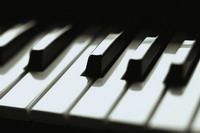Piano Sheets > Howard Dietz Sheet Music > Alone Together (ver. 1) Piano Sheet
Alone Together (ver. 1) by Howard Dietz - Piano Sheets and Free Sheet Music

About the Song
"Alone Together" is a song composed by Arthur Schwartz with lyrics by Howard Dietz. It was introduced in the Broadway musical Flying Colors in 1932 by Jean Sargent.
The song soon became a hit, with Leo Reisman and His Orchestra's 1932 recording being the first to reach the charts. It is the most popular of Schwartz and Dietz's collaborations and has become a jazz standard. The first jazz artist to record the song was Artie Shaw in 1939.[1] Howard Dietz (September 8, 1896 – July 30, 1983) was an American publicist, lyricist, and librettist.
Dietz was born in New York City and studied journalism at Columbia University. He also served as publicist/director of advertising for Samuel Goldwyn Productions and later MGM and is often credited with creating Leo the Lion, its lion mascot, and choosing their slogan Ars Gratia Artis. In 1942, he was made MGM's Vice President in Charge of Publicity..
Download this sheet!
About the Artist

Random article
How to read free sheet music effectively If you are starting out learning how to play piano one of the first things is to learn how to read sheet music for piano. This includes usage of various concepts like treble clefs, bass clefs, key signature and ability to understand actual music notes.
The two clefs
When it comes to piano notes there are two kinds of clefs. Every clef will have a different note in the space and line. The notes typically begin from A and end with G and repeating the pattern again. Starting a piano sheet from C would then take you to D and then E. when it comes to reading sheet music it takes a little more practice and patience. You would need to memorize the music notes through acronyms to make it easier.
(More...)
